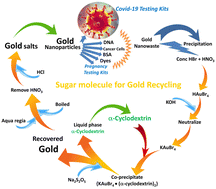Economical gold recovery cycle from bio-sensing AuNPs: an application for nanowaste and COVID-19 testing kits†
Abstract
We report the controlled growth of biologically active compounds: gold nanoparticles (AuNPs) in various shapes, including their green synthesis, characterization, and studies of their applications towards biological, degradation and recycling. Using spectroscopic methods, studies on responsive binding mechanisms of AuNPs with biopolymers herring sperm deoxyribonucleic acid (hsDNA), bovine serum albumin (BSA), dyes degradation study, and exquisitely gold separation studies/recovery from nanowaste, COVID-19 testing kits, and pregnancy testing kits are discussed. The sensing ability of the AuNPs with biopolymers was investigated via various analytical techniques. The rate of degradation of various dyes in the presence and absence of AuNPs was studied by deploying stirring, IR, solar, and UV-Vis methods. AuNPs were found to be the most active cytotoxic agent against human breast cancer cell lines such as MCF-7 and MDAMB-468. Furthermore, an economical process for the recovery of gold traces from nanowaste, COVID-19 detection kits, and pregnancy testing kits was developed using inexpensive and eco-friendly α-cyclodextrin sugar. This method was found to be easy and safest in comparison with the universally accepted cyanidation process. In the future, small gold jewelry makers and related industries would benefit from the proposed gold-recycling process and it might contribute to their socio-economic growth. The methodologies proposed are also beneficial for trace-level forensic investigation.



 Please wait while we load your content...
Please wait while we load your content...